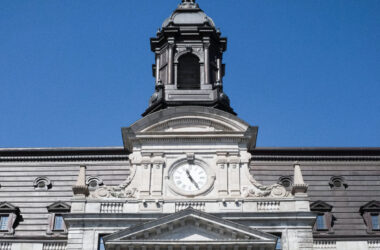Imagine strolling through campus on your way to the studio for CERA 335, Introduction to Ceramics, in a blissful jaunt that stirs your creativity with each step, making you wish you were already sitting at the pottery wheel. You remark, “How wonderful it is that I can study fine art at such a good school! In such a nice city!” To experience this feeling, you’d have to be a student of Concordia University. What’s a Redman to do, then, when he wants to step into a Bumblebee’s shoes?
Concordia offers dozens of BFA programs, ranging from dance to film to computational arts to fibres (if rickety old textile mills stir your passions) to, yes, ceramics. Our neighbour to the east, UQAM, similarly offers graphic arts and design majors. In fact, Montreal’s arts culture seems to surround the McGill campus. Five minutes down Sherbrooke to the west is the Musee des Beaux-Arts, a veritable hotbed of permanent and temporary art, ranging from Greek vases to pieces by Yoko Ono; for the modern art purveyor, the DHC/ART Foundation for Contemporary Art lies just five minutes into the Old Port.
The vibrancy of the Montreal art scene outside of McGill is no accident. Just look at the Quartier des Spectacles. The city’s newest quarter sports opera halls, bars, cinemas, museums, and libraries, spanning more than ten blocks and three metro stations. You can do anything from attend the largest jazz festival in the world, to sit on a park bench and watch denizens run through multicolored fountains on the new Place des Arts plaza. While McGill keeps turning a blind eye to the creative arts, the city of Montreal is picking up the slack. The magnitude of the $120 million Quartier even breaks the current international trend. The U.S. National Endowment for the Arts barely gets $150 million per year for the whole country, and even Holland, once the most supportive arts society in the world, is now cutting its subsidies in half.
Most would be surprised to know that McGill had a Fine Arts program 60 years ago. But true to McGill’s research focus, details of the Fine Arts program are scarce, like a ghost fleeing campus memory with haste. Tracing my way through a maze of obituaries online, one of the few places where records of McGill’s BFA still exist, I tracked down a graduate from as late as 1949. At long last, I found a Gazette article from 1965 in a tangled cobweb of cyber archives. The pure BFA was terminated in 1952, and thereafter a revamped Art History department kept some studio courses. Even then, the aim wasn’t vocational training. Rather, for the students to judge and study creativity, they needed some understanding of what being creative entailed. If you can find the date of the final moratorium for the fated McGill studio arts, email me—it seems to have vanished into thin air.
Instead of being disappointed with McGill’s lack of Fine Arts courses, this seems the perfect reason for indulging in Montreal’s offerings. Stay a while after graduating. Take up mural painting (legally, of course). Independent art schools are numerous in the city’s downtown. Montreal’s proclivity for enhancing the arts seems boundless, and you don’t have to worry about whether you’re a Redman or a Bumblebee to explore the finer sides of Montreal living.






